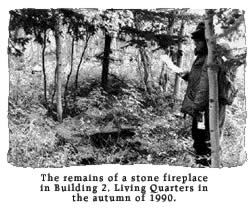|
Northern Vignettes
Arctic Harpoons
Beechey Island
Crystal II
Deline/Fort Franklin
Fort Hope
Fox Moth
Kellet's Storehouse
Naujan
Old Fort Providence
Old Fort Reliance
Stone Church
Thule Village
Yellowknife
Fort Journal
|
Located near Wool Bay outside the City of Yellowknife are the remains of Old Fort Providence, a North West Company, and later a Hudson's Bay Company, trading post.
Historical information is sketchy, although it appears that Fort Providence was important for provisioning other posts rather than for trading in pelts. Correspondence from the post tells that the Dene were sometimes frustrated by the inadequate supply of trade goods available there. Fort Providence did play an important role in supplying John Franklin's first expedition to the Arctic Coast. Franklin stopped there in 1819 and gave the following account.
During the last decade of the eighteenth century, some ten to twenty people, including women and children, lived there. After its amalgamation with the North West Company, the Hudson's Bay Company assumed control of the post in 1821. By this time Fort Providence had been in decline for some years, and by 1822 had dwindled to only a two-man operation. After thirty-seven years of service, the post was abandoned in 1823. Archaeological excavations of Old Fort Providence were conducted in the summers of 1969 and 1971 by B. Dale Perry. The remains of at least four buildings spread over one hectare were discovered. Made of coniferous logs and heated with stone fireplaces, three of these buildings were probably living quarters for the men and officers; the fourth was the large main trade building. The construction method used in the men's quarters is known as post-on-sill in which horizontal sill logs form a framework for vertical posts. The main trade building was identified by the goods including beads, jewellery, musket parts, and ammunition, recovered there.
The buildings of Fort Providence have long since decayed; the site has become overgrown with vegetation, and all that remains visible today are the stone fireplaces. Old Fort Providence should not be confused with the post of the same name located on the Mackenzie River, at the site of the present-day community of Fort Providence. There is still much to be learned from the remains of Old Fort Providence. It is protected from any disturbance by the Northwest Territories Archaeological Sites Regulations. Acknowledgments: "Fort Providence, NWT: A preliminary report of the excavations carried out July 1969." The Musk-ox, No. 8, pp. 1-13, by B. Dale Perry and W. Dean Clark (1971). Narrative of a Journey to the Shores of the Polar Sea in the Years 1819, 20, 21, and 22 by John Franklin. Edmonton, M. G. Hurtig Ltd. pp. 208-209. |
 One of the first posts on Great Slave Lake, it was established in
1786 by Peter Pond, a fur trader and explorer, as an outpost camp
and used for about two seasons. In 1789, Alexander Mackenzie replaced
Pond as the head of the North West Company's operations in the Athabasca
region and re-opened the camp as a trading post. On his exploration
of the great river called Deh Cho by the Dene and which later came
to bear his name, Mackenzie left a trader and a canoe full of goods
to set up the post.
One of the first posts on Great Slave Lake, it was established in
1786 by Peter Pond, a fur trader and explorer, as an outpost camp
and used for about two seasons. In 1789, Alexander Mackenzie replaced
Pond as the head of the North West Company's operations in the Athabasca
region and re-opened the camp as a trading post. On his exploration
of the great river called Deh Cho by the Dene and which later came
to bear his name, Mackenzie left a trader and a canoe full of goods
to set up the post. 